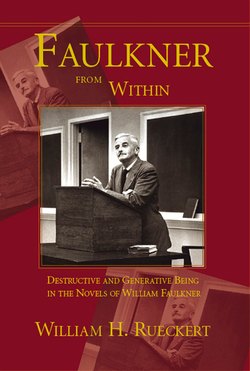Читать книгу Faulkner from Within - William H. Rueckert - Страница 7
На сайте Литреса книга снята с продажи.
ОглавлениеAcknowledgments
This book has been a long time in the making and like any book this long, which has gone through so many revisions, it owes a lot to its many devoted typists. I acknowledge them all with gratitude. Two of these recent typists have been heroic in their devotion to this manuscript: Gail English (with some help from Marie Henry), one of our secretaries in the English Department at SUNY/Geneseo, put the whole text on disks for me the year that I retired so that I would be sure to finish it after I retired; and my wife, Barbara, has reformatted it, printed it all out for me, proofread the printout against the original typescript, made all the corrections and revisions, typed the new parts and retyped some of the old ones, checked all of the quotations against the originals, and, in general like a good copy editor, has made sure that we had a manuscript that was as error-free as possible. She also printed the final copy that went to the press. Had it not been for these two and the miracle of the Mac Plus (I still work on a Hermes 3000 manual typewriter), this study of Faulkner would have died in its dusty box on the shelf in my study where I put it some years ago—in anger, frustration, disgust, and uncharacteristic critical apathy. My wife, in particular, became as obsessed with finishing this manuscript as I was. She learned everything she needed to learn in order to do what was necessary on the word processor; in addition, she gave me excellent advice about revisions, especially the best kind, deletions. I would never have finished without her help.
Many other people have also been a great help with this study. Chief among these are all the wonderful students who studied Faulkner with me at the University of Illinois, the University of Rochester, and the State University of New York at Geneseo. I have also discussed Faulkner with many of my colleagues and some have also been kind enough to read the manuscript. I wish to thank, especially, Frank Hodgins, who first taught me something about the greatness of “The Bear”; Milton Stern, a Faulkner enthusiast, along with Frank Hodgins, and later, a careful, thoughtful, incisive reader of an earlier version of this study; Sherman Paul, another careful and encouraging reader of an earlier version of this study; Howard Horsford, whose brilliant formalist reading of The Sound and the Fury provoked me to go beyond it in ways he could not have anticipated; Leroy Searle, with whom I team-taught modern American literature at Rochester and whose teaching of Absalom, Absalom! was a marvel to behold; Jay Martin, who read an early version of this manuscript and assured me that, though I did not yet, I might someday have here a “great” book on Faulkner; Clay Lewis, a great reader of Faulkner, a wonderful dialectician of a colleague; and John Michael, who kept assuring me that there was a lot of good stuff in there (in the dusty box) and that if I was not going to finish my Faulkner, would I please give it to him.
Numerous institutions, departments and friends have also helped in different ways. The University of Rochester and the English department there supported my work in many different and valuable ways during the nine years that I was there; while I was a Visiting University Fellow at Empire State College in Saratoga Springs, helping to get that college conceived and underway, I did a pilot study of Faulkner as one of their self-teaching “modules” that was really the genesis of the present book. The staff at Furness House, where we were housed, especially those responsible for putting the modules into finished form, was extremely helpful, as were my colleagues there. The State University of New York at Geneseo, especially the staff of the English department, helped me with this work in many ways too numerous to enumerate during my years there. Darla Penta, my secretary when I was chair, was especially helpful, as were Marie Henry and Gail English. Important parts of this study were written one summer in Maine when Stan and Judy Kahrl kindly loaned us their wonderful house on Kennebec Point. I want to thank them here for their hospitality and generosity, and for teaching me something about what friendship means. Finally, Theron Francis was a wonderful copy editor who improved the text in many important ways; and David Blakesley, who runs Parlor Press, is largely responsible for making sure this study of Faulkner became a book.
